Why Travel Tibet in Winter?
Winter is the time when sunshine cares for Tibetan areas. You rarely encounter rain, and it is sunny most of the time, and the temperature in Nyingchi and Lhasa can reach more than 10 degrees at noon.
Winter is the off-season in Tibet. Not only are there few people, but from November, scenic spots above Grade 3A have implemented a free ticket system, and some scenic spots that usually charge tickets are also given at least half price according to industry regulations.
In winter, many lakes form crystal-clear ice. You can slide and play on the ice, and you can also take interesting photos. The verdant virgin forest will be covered with a light white in winter, which is different from the scenery of Tibet in summer.
What Attractions are Worth Traveling to in Tibetan Winter?
Potala Palace
As the first batch of national key cultural relics protection units, the Potala Palace in the peak season has been strictly implementing the 2-hour time limit visit policy, booking a day in advance, and limiting the number of people every day, and the ticket price is high. The winter tour of Tibet activities Potala Palace scenic spot tickets do not need to make an appointment in advance, and with unlimited time, you can slowly appreciate the cultural relics and historical precipitation in the palace. Zongjiao Lukang Park, located behind the Potala Palace, has a pond that is the best place to photograph the reflection of the Potala Palace.
Basum Lake
Basum Lake is one of the few lakes in Tibet that does not freeze in winter. In winter, the lake here is changeable in color along the sunshine, and rows of villages are scattered along the lake. Although it is not as gorgeous as the peach blossoms, it is also full of vitality.
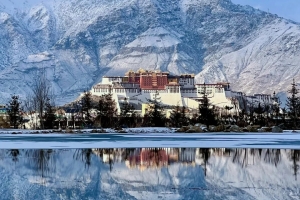
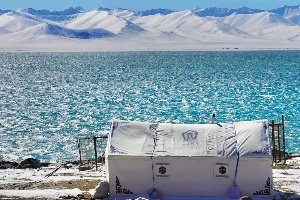
Potala Palace in Winter Namtso Lake in Winter
Yamdrok Lake
In winter, Yamdrok Lake is quiet and moving. The clear and transparent sky-blue lake water echoes the blue sky and white clouds, which are quiet and holy, like a beautiful woman in plain clothes lying in the arms of Himalayan peaks.
Namtso Lake
Namtso in winter is frozen thousands of miles, and the line of sight appears only blue and white, emitting a breathtaking charm. However, the road to Namtso in winter is prone to heavy snow closure, so you must inquire about the exact news before going.
Brahmaputra Grand Canyon
In winter, the Brahmaputra Grand Canyon can clearly see the whole picture of Namcha Barwa, and only this season can be seen almost every day. Tickets to the Grand Canyon are usually expensive, while if you choose to go in winter, you can save a lot of money.
Lulang Forest
Lulang is wrapped in silver in winter, and the snow-capped mountains and glaciers in the distance complement each other with the virgin forests, villages, and rivers nearby, like the magnificent White Dragon Palace.
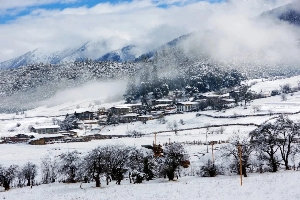
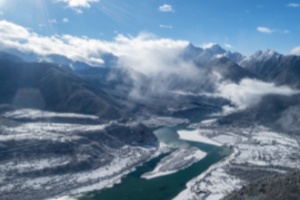
Lulang Forest in Winter Brahmaputra Grand Canyon in Winter
Recommended Specific Tour Itinerary
Day1: When you arrive in Lhasa, we will wait for you with the pick-up sign. Then you will take the arranged car to the hotel to rest. (Tips: After arriving at the hotel on the first day of arriving in Tibet, have a good rest, and let your bodies adapt to the plateau environment so that it won’t be so easy to have high reactions later)
Day2: This day is mainly to visit Lhasa. There are many cultural landscapes in Lhasa, which can travel all year round. The main scenic spots are Potala Palace, Peace Monument, and Jokhang Temple. This day's trip will make you feel the faith of the Tibetan people.
Day3: Leave Lhasa and start a tour of Nyingchi. Go to Ghading Valley in the morning, where the waterfall falls nearly 200 meters, which is spectacular. In the afternoon, go to Lulang Forest, where you can watch the beautiful scenery, play horse riding and archery, live in Lulang in the evening. I suggest you to eat Lulang Stone Pot Chicken in the evening, which is really delicious and healthy.
Day4: On this day, you will still play in Nyingchi. After breakfast, you will leave Lulang for Yani Wetland Park, where you can see the panoramic view of Yani Wetland Park by taking the glass plank road in online celebrity. Go to Yarlung Zangbo Grand Canyon in the afternoon, where you can see many rare animals and plants, and you can also see Namcha Barwa on the observation deck. After that, you will set off for Basum and stay in Basum scenic spot at night.
Day5: When you wake up in the morning, you can see the beautiful scenery of Basum. After breakfast, you can move freely in Basum scenic spot. Go to Tibetan folk Village in the afternoon, where you can taste delicious food and try Zanba and butter tea. Return to the Lhasa Hotel in the evening.
Day6: After breakfast, you will go from Lhasa to Yamdrok Lake, one of the three holy lakes, and have close contact with it. After the tour, return to Lhasa and I recommend a rich yak soup pot for dinner.
Day7: Go to Barkhor Street in the morning to buy some special local products, and take a car to the airport in the afternoon.
What Can You Do in Tibetan Winter Tour?
Feel the most pious faith
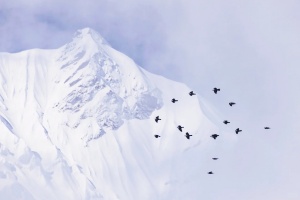 Birds in Tibet Winter
Birds in Tibet Winter
No matter when you go to Jokhang Temple, you can see Tibetan compatriots wearing all shabby cotton-padded clothes worshipping. Compared with summer, Lhasa in winter is Lhasa belonging to Tibetans. Recommended locations: Jokhang Temple, Drepung Monastery, and Sera Temple.
Start a bird-watching tour
Winter is the best time to watch birds in Lhasa. At that time, you can not only see the most magnificent migratory birds flying but also have precious birds such as black-necked cranes, spotted geese, and red ducks. According to statistics, there are more than 130 kinds of birds in Lhasa city and lakes and wetlands in winter.
Start a mountain tour
In summer, due to the changeable climate on the plateau, it is difficult for the sacred mountains surrounded by clouds and fog to show their majestic faces. Winter is an excellent season to watch the holy snow-capped mountains in Tibet, and it is easier to appreciate the “true face” of the majestic snow-capped mountains. Recommended mountains: Namcha Barwa.




































